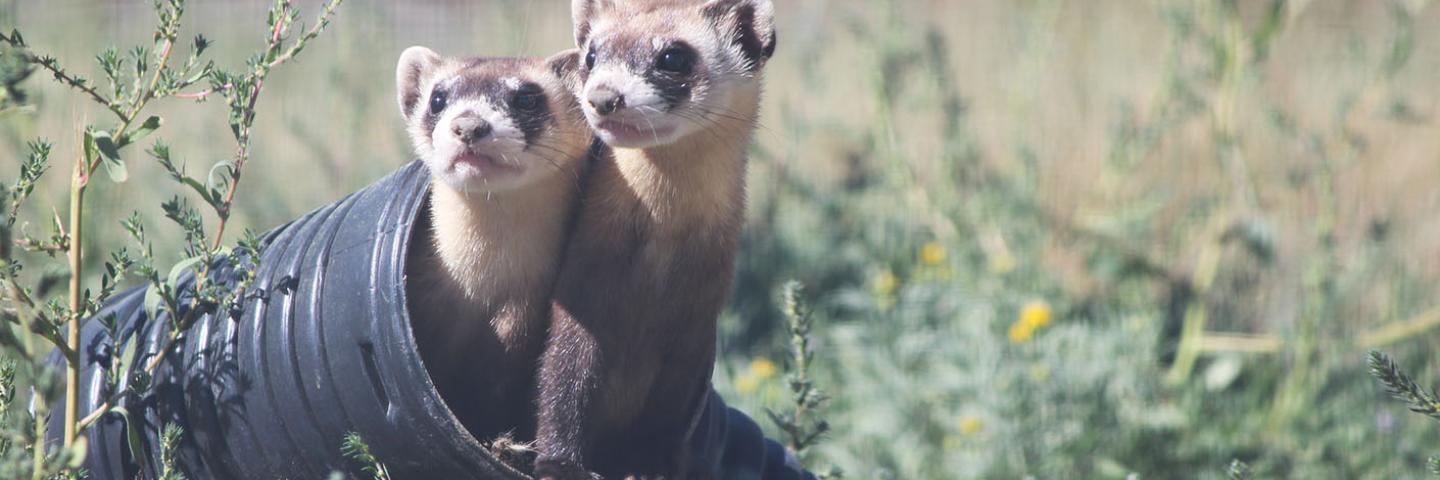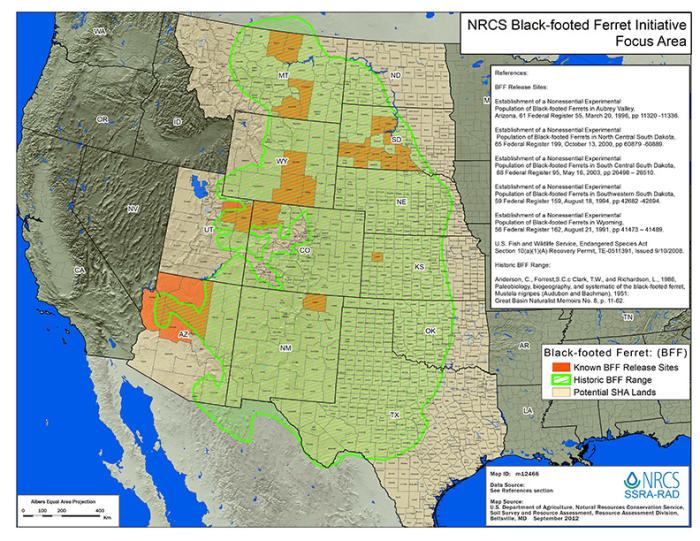
The purpose of the BFF effort is to promote voluntary, incentive-based conservation on private and Tribal lands, with the primary objective of encouraging landowner participation in black-footed ferret (BFF) recovery while strengthening the productive capacity of working lands and rural economies.
FY-24 Ranking Information
About the NRCS BFF Initiative
The NRCS in Colorado supports black-footed ferret (BFF) recovery efforts as outlined within a Memorandum of Understanding (MOU) with the USFWS, APHIS-WS, Western Association of Fish and Wildlife Agencies, and the U.S. Geological Survey.
- The implementation of the BFF effort was authorized on a voluntary basis within 12 states where prairie dogs occur including Arizona, Colorado, Kansas, Montana, Nebraska, New Mexico, North Dakota, Oklahoma, South Dakota, Texas, Utah and Wyoming because prairie dogs are the primary and preferred diet of the BFF and the dog’s habitat is also desirable.
- NRCS provides technical and financial assistance for the special effort thru conservation efforts with willing landowners to maintain ranch land in prairie habitats and the livestock operations that they support, while also providing for the conservation and recovery of several wildlife species associated with prairie dogs.
- Only sites that are eligible for the2013 BFF Safe Harbor Agreement for ESA Section 10(j) (as determined by US Fish & Wildlife Service BFF recovery team) and for EQIP will be considered eligible for the BFF Special Effort.
- The USFWS BFF recovery team will make the final determination if a site is eligible. If found eligible, the USFWS will enter into more in-depth discussion with the landowner on their goals and objectives, assessment of potential conflicts with adjoining landowners, and boundary configurations of the Conservation and Management Zones.
This effort is being implemented across the species range encompassing portions of 12 states and overlap to prairie dog overall range. The goal in this effort is to assist in the recovery of this federally endangered species.
NRCS’ support will assist participating landowners in implementing prescribed grazing plans and other measures as requested, to address conservation concerns.
Application Forms
For funding consideration, complete the application using form CPA-1200 "NRCS Conservation Program Application" located on the Colorado EQIP webpage where you can also view the Ranking Documents, Eligible Practices & Payment Rates. You may complete and print the form online.
More Information
- A copy of the U.S. Fish & Wildlife Service’s BFF Recovery plan is available for more information.
- Read more about protecting black-footed ferrets and prairie dogs against plague.
Additional Information
Apply for Environmental Quality Incentives Program (EQIP)
The Environmental Quality Incentives Program (EQIP) provides financial and technical assistance to agricultural producers and non-industrial forest managers.
Learn MoreFarm Bill
The 2018 Farm Bill was enacted on December 20, 2018. The Farm Bill continues its strong support for conservation efforts of America’s farmers and ranchers through reauthorization and expanded flexibility of NRCS conservation programs.
Learn MoreReady to get started?
Contact your local service center to start your application.
How to Get Assistance
Do you farm or ranch and want to make improvements to the land that you own or lease?
Natural Resources Conservation Service offers technical and financial assistance to help farmers, ranchers and forest landowners.

To get started with NRCS, we recommend you stop by your local NRCS field office. We’ll discuss your vision for your land.
NRCS provides landowners with free technical assistance, or advice, for their land. Common technical assistance includes: resource assessment, practice design and resource monitoring. Your conservation planner will help you determine if financial assistance is right for you.
We’ll walk you through the application process. To get started on applying for financial assistance, we’ll work with you:
- To fill out an AD 1026, which ensures a conservation plan is in place before lands with highly erodible soils are farmed. It also ensures that identified wetland areas are protected.
- To meet other eligibility certifications.
Once complete, we’ll work with you on the application, or CPA 1200.
Applications for most programs are accepted on a continuous basis, but they’re considered for funding in different ranking periods. Be sure to ask your local NRCS district conservationist about the deadline for the ranking period to ensure you turn in your application in time.
As part of the application process, we’ll check to see if you are eligible. To do this, you’ll need to bring:
- An official tax ID (Social Security number or an employer ID)
- A property deed or lease agreement to show you have control of the property; and
- A farm number.
If you don’t have a farm number, you can get one from USDA’s Farm Service Agency. Typically, the local FSA office is located in the same building as the local NRCS office. You only need a farm number if you’re interested in financial assistance.
NRCS will take a look at the applications and rank them according to local resource concerns, the amount of conservation benefits the work will provide and the needs of applicants. View Application Ranking Dates by State.
If you’re selected, you can choose whether to sign the contract for the work to be done.
Once you sign the contract, you’ll be provided standards and specifications for completing the practice or practices, and then you will have a specified amount of time to implement. Once the work is implemented and inspected, you’ll be paid the rate of compensation for the work if it meets NRCS standards and specifications.


